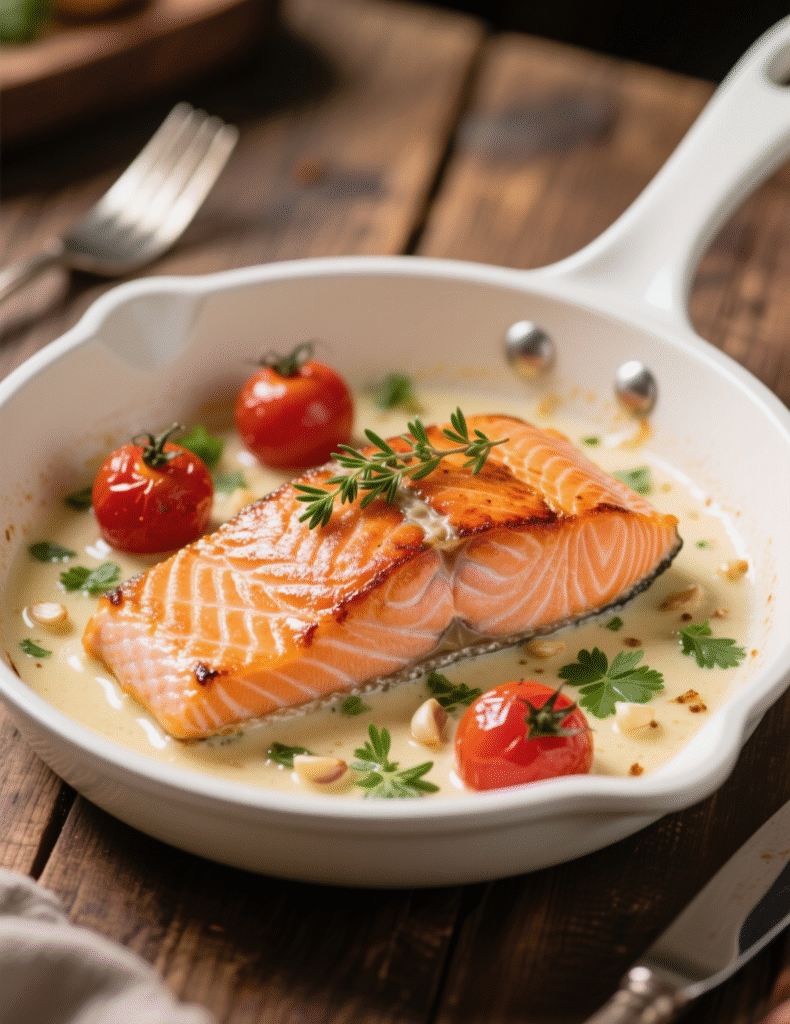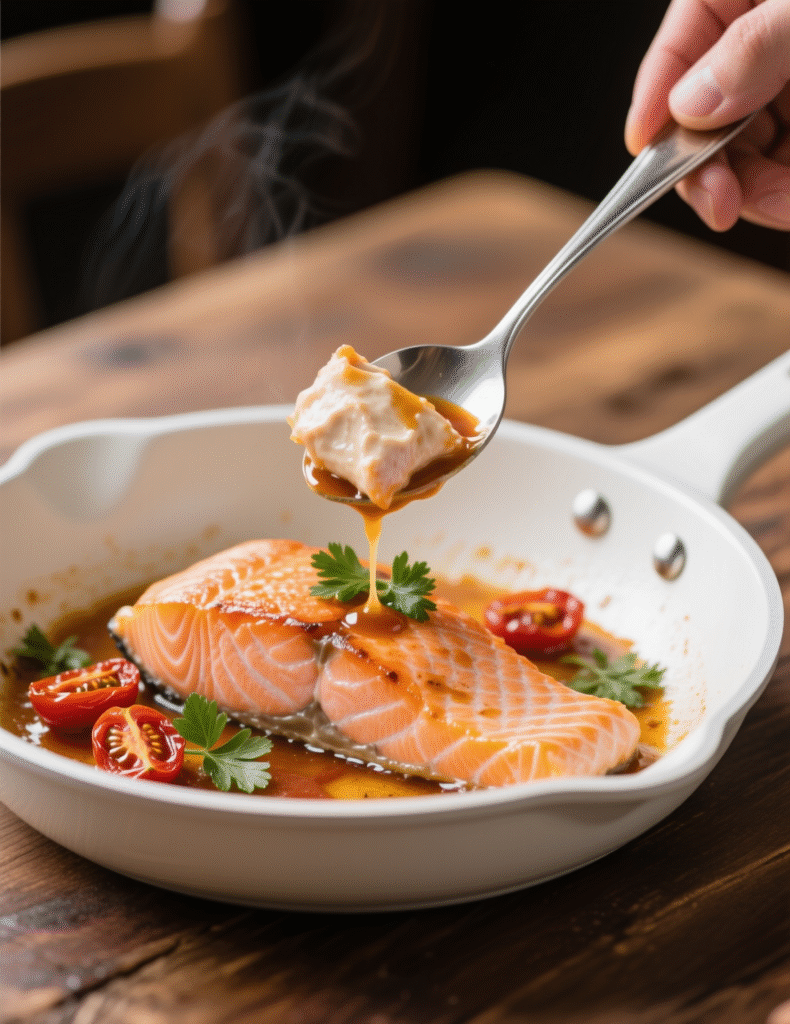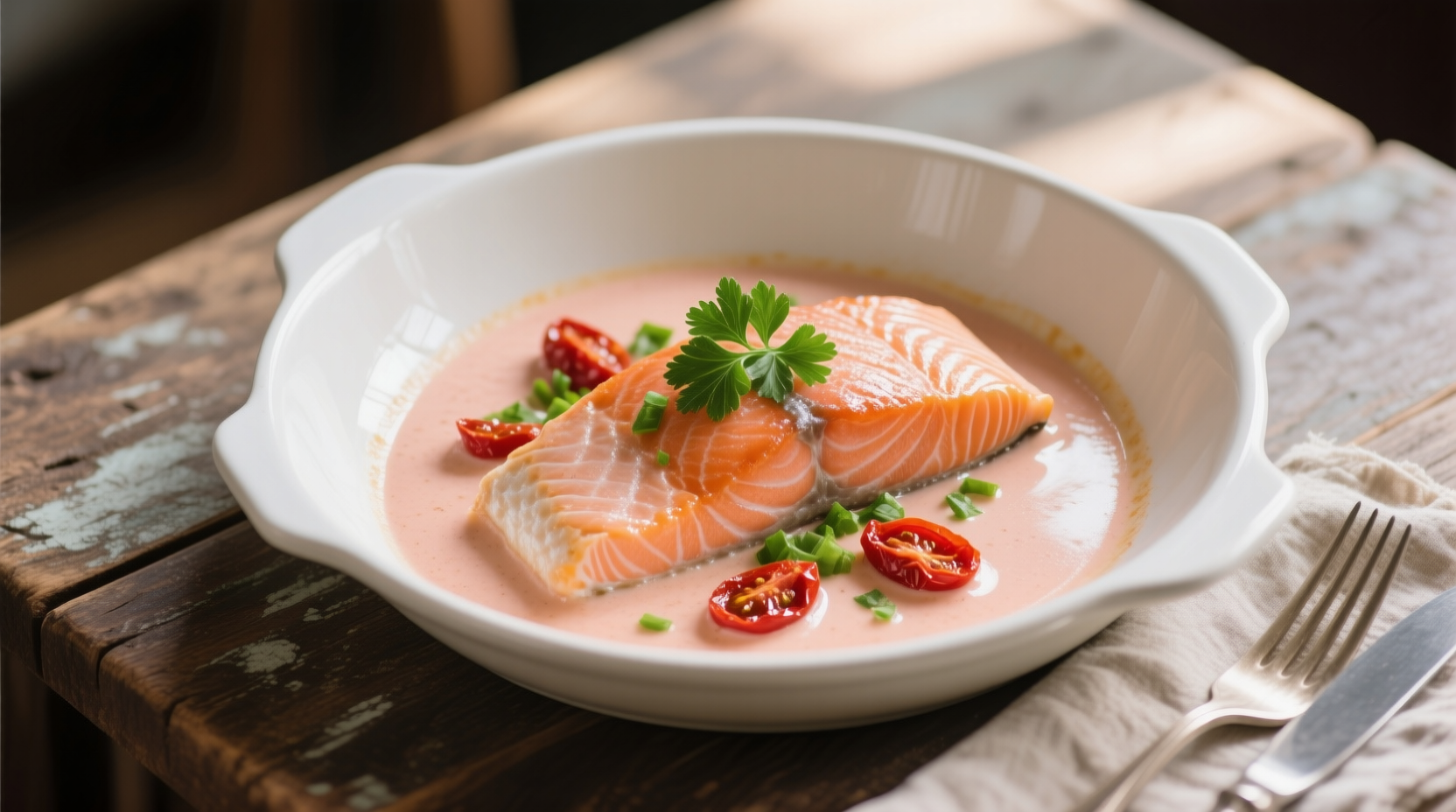Salmon already has that natural richness, but when you pair it with a creamy sauce, garlic, sun-dried tomatoes, and a few herbs, you get something that doesn’t just feed hunger—it convinces people they should stay a little longer at the table. Some dishes whisper elegance, this one shouts it, but with velvet gloves on. The famous “Marry Me” chicken recipe has been floating around for years, yet salmon takes it to a level that feels leaner, fresher, and more sophisticated.
Chefs who work with salmon know it’s a bit of a tricky fish. Too much heat and it dries, too little and it feels slimy. The magic of this recipe lies in how the sauce acts like an insurance policy, sealing moisture while adding bold layers of flavor. You’re not just cooking salmon—you’re building an experience that tastes like a story you’ve told a hundred times but somehow never gets old.
Why Salmon and Cream Are Such Old Friends
Fat loves fat, and salmon has plenty of natural oils that demand a partner strong enough to stand beside them. Cream is that partner. Unlike lean proteins such as chicken breast or cod, salmon can handle a sauce that’s almost too much—garlic butter, heavy cream, parmesan—and still not lose itself.
In culinary science, this pairing makes sense. Omega-3-rich fish like salmon benefit from acid and fat in sauces to balance the palate. Without that counterweight, the fish can taste overly oily. Cream cuts and coats, creating harmony. The sun-dried tomatoes bring in a sweet-tart punch that cleans the richness, while parmesan sneaks in salt and depth.
That trifecta—cream, tomato, cheese—builds a sauce that’s nearly impossible to mess up. You could reduce it too long, and it’s still luscious. You could under-season slightly, and the cheese saves you. This is why professionals lean on such combinations in kitchens with little room for error.
One-Pan Cooking and Its Professional Allure
Restaurants love one-pan dishes, not because they’re lazy but because they’re efficient. Fewer pans mean fewer flavors lost in transfer, fewer interruptions in the cooking rhythm. Marry Me Salmon follows that logic perfectly. You sear, you build, you finish—all in one place.
Professional kitchens call this “layered cooking.” You sear the salmon, remove it, build a sauce in the fond left behind, then return the fish to the pan. Those tiny caramelized bits at the bottom aren’t scraps—they’re gold. Deglazing them with broth or wine unlocks a depth that a clean pan would never give you.
At home, the beauty is practical too. Less mess, fewer dishes, and a dish that feels five-star with a cleanup that doesn’t break your evening.
Ingredients That Matter More Than They Look
Every ingredient here pulls weight. Substituting thoughtlessly can unravel the balance.
- Salmon: Skin-on fillets are best. The skin protects against overcooking and adds a crisp contrast. Wild-caught sockeye gives intense flavor, while Atlantic farmed salmon has a fattier, milder profile. Both work, but the sauce will cling differently.
- Garlic: Fresh garlic, not powder. You want the aromatic oils released when it hits hot butter. Powder will never give that.
- Sun-dried Tomatoes: Oil-packed, not dry. The oil carries flavor, and chopping them fine spreads that sweetness evenly.
- Heavy Cream: Don’t use milk or half-and-half. They’ll split under heat. Cream stabilizes, especially when reduced.
- Parmesan: Aged Parmigiano-Reggiano melts smoother and sharper than cheap shredded bags. If you only change one thing, make it this.
The success of this recipe isn’t just about steps—it’s about ingredient respect.

Technique: Where the Real Flavor Lives
Searing salmon properly is non-negotiable. You want the Maillard reaction—the caramelized crust that forms when proteins meet high heat. That crust locks flavor in, while the inside stays tender. Too low a heat and you steam, not sear. Too high and you scorch. Professionals aim for medium-high, adding oil only when the pan itself is hot enough to shimmer.
After searing, you remove the salmon. Don’t cook it through here—it’ll finish in the sauce. This prevents dryness. Then, the fond becomes your canvas. Garlic goes in, but quickly; garlic burns faster than most think, and burnt garlic ruins a sauce with bitter edges. Deglaze with stock or a splash of white wine, then fold in cream, tomatoes, and parmesan.
Simmering, not boiling, thickens the sauce. Boiling separates cream. Patience makes this sauce cling rather than run. When the salmon re-enters, it finishes cooking gently, absorbing all those flavors. Professionals call this “carryover cooking,” letting the residual heat do the work.
Variations That Work and Those That Don’t
Some chefs try to lighten the dish with yogurt or coconut milk. These substitutions shift the flavor profile so much that you’re cooking something else entirely. Yogurt splits when heated aggressively. Coconut milk adds sweetness that fights parmesan. If you want dairy-free, cashew cream is a stronger contender.
Herb swaps are fair game. Basil feels Italian, thyme adds woodiness, parsley brightens. Rosemary is too aggressive and will dominate. Chili flakes are optional but recommended; heat cuts richness beautifully.
Carbohydrate pairings matter too. Rice soaks sauce, pasta carries it, mashed potatoes cradle it. Polenta is an underused partner here—it echoes the Italian soul of the dish but adds a rustic comfort.
Nutritional Considerations in a Professional Context
A single portion of Marry Me Salmon delivers roughly 450–600 calories depending on portion size and fat choices. Protein sits around 35–40 grams per serving, while fats can be 30+ grams.
This is not a “light” dish, nor should it be disguised as one. It’s indulgent but nutrient-dense. The omega-3s in salmon offset some of the guilt, with research consistently showing benefits for cardiovascular and brain health (Harvard T.H. Chan School of Public Health, 2021). Cream and parmesan, while calorie-heavy, deliver calcium and satisfaction. In professional kitchens, dishes like this are positioned as “occasional indulgences” on menus, not daily fare.
Why the “Marry Me” Name Resonates
Food that tastes good makes people happy. Food that makes people emotional becomes memorable. The playful name “Marry Me Salmon” taps into that idea. It’s less about proposals and more about a dish so good it elicits exaggerated declarations. That kind of branding sticks in restaurants—it creates stories guests repeat.
In professional kitchens, names matter almost as much as recipes. “Pan-seared salmon in creamy sun-dried tomato sauce” describes. “Marry Me Salmon” sells.
Common Mistakes Professionals Still Make
Even seasoned chefs stumble with creamy pan sauces. Overcrowding the pan steams instead of sears. Adding cream too early reduces it too far before balance is achieved. Using cheap parmesan results in grainy, broken sauce.
Timing salmon’s doneness is another pitfall. The USDA recommends 145°F (63°C), but many chefs pull salmon at 125–130°F for medium, letting carryover heat finish. Texture at this range is buttery, not chalky.

Emerging Trends and Professional Twists
High-end restaurants are adapting this recipe with modern touches. Some replace sun-dried tomatoes with roasted red peppers for a sweeter note. Others use smoked salmon belly trimmings in the sauce itself to intensify depth. Plant-based chefs mimic the dish with roasted carrots or king oyster mushrooms in creamy cashew sauce, branding it “Marry Me Veggies.”
Another trend is portion flexibility. Mini cast-iron skillets presenting individual salmon fillets look dramatic in fine dining settings. On the other hand, large one-pan family-style servings dominate home cooking blogs, where rustic plating feels more genuine.
Conclusion: Why This Recipe Belongs in Every Cook’s Repertoire
Marry Me Salmon is more than a viral dish—it’s a masterclass in balance. Richness meets acidity, efficiency meets elegance, indulgence meets nutrition. It teaches searing, sauce-making, and ingredient respect in one pan.
For professionals, it’s a reliable addition to menus that demand impact with minimal risk. For home cooks, it’s a dish that feels like a luxury dinner without the fuss of complicated methods.
The takeaway is simple: technique protects the fish, sauce carries the story, and the name seals the memory. Cook it right, and you’ll understand why people say yes before the fork even leaves their hand.
FAQs
What is Marry Me Salmon?
It’s a creamy, one-pan salmon dish with garlic, cream, parmesan, and sun-dried tomatoes.
Why is it called Marry Me Salmon?
The name suggests it’s so delicious it could win anyone’s heart instantly.
Can I use frozen salmon for this recipe?
Yes, but thaw completely and pat dry before searing to avoid excess moisture.
What type of cream works best?
Heavy cream works best since it won’t split under heat like milk or half-and-half.
Do I need to keep the salmon skin on?
Yes, skin-on fillets protect the fish from overcooking and add texture.
Can I substitute sun-dried tomatoes?
Roasted red peppers can work, but they’ll give a sweeter flavor profile.
How do I know when salmon is cooked?
Pull it at 125–130°F for medium doneness and let carryover heat finish cooking.
Is this dish healthy?
It’s indulgent but nutrient-dense, packed with omega-3s, protein, and calcium.
What’s the best side to serve with Marry Me Salmon?
Rice, pasta, mashed potatoes, or creamy polenta pair beautifully with the sauce.
Can this be made dairy-free?
Yes, cashew cream is the best substitute, though flavor will change slightly.

Mariana is a passionate home cook who creates delicious, easy-to-follow recipes for busy people. From energizing breakfasts to satisfying dinners and indulgent desserts, her dishes are designed to fuel both your body and hustle.
When she’s not in the kitchen, she’s exploring new flavors and dreaming up her next recipe to share with the Foodie Hustle community.

